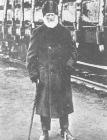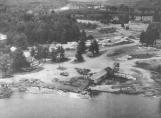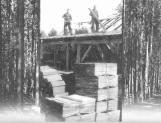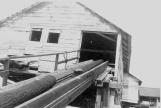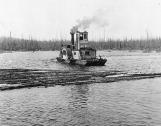10
J. R. Booth was the largest timber baron in Canada and had thousands of acres of timber rights in a large part of Ontario. His main operation was in Ottawa near the old Union train station. After the river was no longer used for movement of the logs, Booth built the Ottawa, Arnprior and Parry Sound railway in the mid 1890’s to transport the logs to their markets in the USA and Canada. That railway came to Barry’s Bay in 1894.12
Where the Madawaska River empties into Kamaniskeg Lake, there was a wooden sorting table were the logs were directed down the lake. At the bottom of the lake where Chippawa Cottage Resort is now located was an area called 'The Depot'. It was a place for further sorting of logs and a sawmill was also located there in the late 1890’s for many years.At Palmer Rapids, there was another major problem getting logs around that set of rapids. Several loggers lost their life there and were buried in a small cemetery on top of a hill at the original site of the village of Palmer Rapids off Dam Road near Jewelville.
Other sawmills in the area included Daniel Johnson’s sawmill business at Johnson Creek; Orams sawmill behind the Valley Market store on a creek there.
14
PASTWAY LUMBER MILLIn the winter of 1929 after several other careers in Saskatchewan working the wheat harvest and in Galetta lead mine Frank Pastway and his brother Steve worked together at Bruly Lake in Algonquin Park cutting logs using only cross-cut saws.
In the spring of 1936, Frank purchased a sawmill in Combermere where he used the mill to hash grain and cut wooden shingles. At the end that summer he moved the mill to Halfway and continued the same operations.
In the summer of 1937 the mill was moved back to Combermere where Frank began custom sawing for Murray Brothers, employing local men who roomed and boarded at the Pastway Mill
In the fall of 1938 the mill was completely destroyed by fire but Frank was determined to rebuild it. In the summer of 1949, disaster struck again when another fire destroyed the mill.
16
In 1950, Frank bought a mill from Henry Chapeskie Sr. which was located behind St. Hedwig’s Church and cemetery in Barry’s Bay. He operated this site for many years and then moved it to Harvey Lake, east of Rolphton where he sawed logs for Shaw Lumber Co. In 1952 this mill was rented to Barney Miller and Sons of Eganville (now M.N. Miller and sons)At his mill in Combermere Frank continued to operate, employing local men, sawing his own logs and those for Murray Brothers.
In the fall of 1972, after 36 years in the lumber business, Frank retired but remained a strong interest in the lumber industry. He liked hunting and traveling to family members and playing cards.
His son Raphael (Ray) started a planning mill not far from Franks mill. It is one of the largest pressure treatment plants in Ontario
18
Drohan & Fleguel SawmillJohn Drohan built a sawmill in 1944 at the end of McPhee’s Bay off Negeek Lake of the Madawaska River south of Combermere. John also had a portable sawmill in the Barry’s Bay area near Paugh Lake. The Drohan & Fleguel Mill operated through the 1940-50’s and closed in November 1965. It was a large sawmill employing eighteen people with Henry Fleguel as sawmill boss. The mill could cut 50,000 board feet of lumber in a 10-hour day shift. The sawmill had a high pressure boiler to operate the sawmill machinery. There was also a generator to provide electricity for the mill. On the site there was a blacksmith shop, sleep camps, cookhouse and office.
21
In the late fall and winter the sawmill men worked in the lumberyard and the bush cutting saw logs for the sawing season in the spring, summer and fall.Drohan Lumber Company had a lumberyard in Barry’s Bay where Drohan Street is today and along Kelly Street.
John T. Drohan, lumberman in Barry’s Bay died on November 14, 1952 at the age of 57 years.
